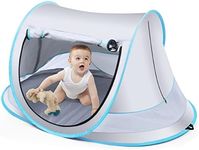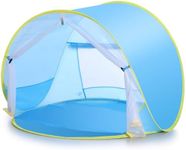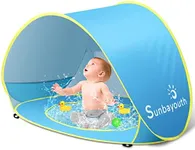Buying Guide for the Best Baby Shade Tent
Choosing a baby shade tent is all about keeping your little one safe and comfortable while spending time outdoors. These tents are designed to provide protection from the sun, wind, and sometimes even insects, making them perfect for trips to the beach, park, or backyard. When picking the right tent, it's important to consider how and where you'll use it, how easy it is to set up, and how well it will protect your baby from the elements. Understanding the key features will help you make a choice that fits your family's needs and lifestyle.UV Protection RatingThe UV protection rating tells you how well the tent blocks harmful ultraviolet rays from the sun. This is important because babies have sensitive skin that can burn easily. Tents are usually rated with a UPF (Ultraviolet Protection Factor) number, such as UPF 30, 40, or 50+. The higher the number, the better the protection. For most outdoor use, a UPF 50+ tent is ideal, as it blocks out over 98% of UV rays. If you plan to use the tent in very sunny places or for long periods, always go for the highest UPF rating you can find.
Size and SpaceThe size of the tent determines how much room your baby will have to play, nap, or move around. Some tents are compact and just fit one baby, while others are larger and can accommodate more than one child or even a parent. If you only need a spot for your baby to rest, a smaller tent is easier to carry and set up. If you want space for toys, changing diapers, or sitting with your baby, look for a larger tent. Think about how many children will use it and what activities you'll do inside to pick the right size.
VentilationVentilation refers to how well air flows through the tent. Good ventilation is important to keep your baby cool and comfortable, especially on hot days. Tents with mesh windows or panels allow air to circulate and help prevent the inside from getting stuffy. Some tents have roll-up flaps or multiple openings for extra airflow. If you plan to use the tent in warm weather, make sure it has enough mesh areas to keep your baby from overheating.
Portability and Ease of SetupPortability is about how easy it is to carry the tent and set it up wherever you go. Some tents are lightweight and fold into a small bag, making them easy to take to the beach or park. Others might be bulkier or require more time to assemble. If you want something quick and hassle-free, look for a pop-up design that opens in seconds. If you don’t mind spending a little more time, a tent with poles might offer more stability. Consider how often you'll move the tent and how much effort you want to spend setting it up.
Water ResistanceWater resistance means the tent can protect your baby from light rain or damp ground. Some tents have a waterproof floor or water-repellent fabric, which is useful if you’re using it on wet grass or if there’s a chance of rain. If you plan to use the tent mainly at the beach or in dry weather, this might not be as important. But for parks or unpredictable weather, a water-resistant tent adds extra comfort and protection.
Safety FeaturesSafety features include things like secure anchoring, soft materials, and no sharp edges. Some tents come with stakes or sand pockets to keep them from blowing away in the wind. Others have zippers or flaps to keep bugs out. Always check that the tent is made from non-toxic materials and that there are no small parts that could be a choking hazard. If you’ll use the tent in windy areas or on uneven ground, make sure it can be anchored securely.








